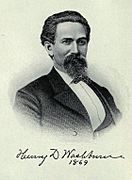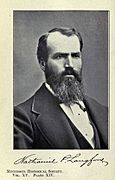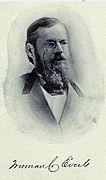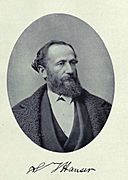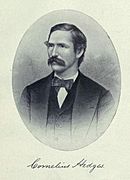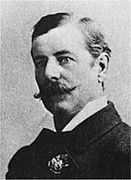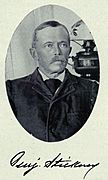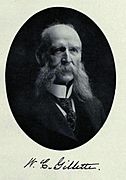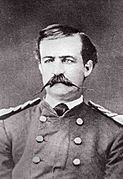Washburn–Langford–Doane Expedition facts for kids
The Washburn Expedition was a special trip in 1870 that explored a part of northwestern Wyoming. This area later became Yellowstone National Park just two years later. The expedition was led by Henry D. Washburn and Nathaniel P. Langford. They also had a U.S. Army group with them, led by Lt. Gustavus Cheyney Doane. Their journey followed a similar path to an earlier trip called the Cook–Folsom–Peterson Expedition from the year before.
During their adventure, the people on the expedition made detailed maps and wrote down what they saw in the Yellowstone area. They explored many lakes, climbed several mountains, and watched the local wildlife. The group visited both the Upper and Lower Geyser Basins. After watching one geyser erupt regularly, they decided to name it Old Faithful. It erupted about every 74 minutes, which was very reliable!
One person on the trip, Cornelius Hedges, was a writer and lawyer from Montana. He later wrote many articles for a newspaper in Helena, Montana. He described all the amazing things the expedition had seen. In talks with others and in his newspaper articles, Hedges strongly supported the idea of making the Yellowstone region a National Park. This idea was first suggested by Thomas Francis Meagher, who used to be a governor in Montana.
Contents
Why the Expedition Happened
The Washburn group was really inspired by the notes and stories from Charles W. Cook and David E. Folsom's earlier trip. Right after the Cook–Folsom–Peterson Expedition, Folsom even started working as a surveyor for Washburn.
Also, Langford knew Jay Cooke from the Northern Pacific Railroad before their trip. Cooke was interested in how the Yellowstone area could bring more business to his railroad. After the expedition, Cooke paid for Langford to give speeches in 1871. Langford spoke in cities like New York and Washington, D.C., telling everyone about the 1870 expedition for the railroad.
On January 19, 1871, geologist Ferdinand Vandeveer Hayden heard one of Langford's speeches in Washington, D.C. Hayden was so inspired that he decided to do his next geological survey in the Yellowstone region. This led to the famous Hayden Geological Survey of 1871.
Who Was on the Expedition?
The Washburn Expedition had a mix of civilian explorers and military escorts.
- Civilian Members
- Henry D. Washburn – He was chosen as the leader and was Montana's Surveyor-General.
- Nathaniel P. Langford – He used to collect taxes for the U.S. in Montana Territory.
- Truman C. Everts – He used to assess taxes for the U.S. in the Montana Territory.
- Judge Cornelius Hedges – He was a U.S. Attorney in the Montana Territory.
- Samuel T. Hauser – He was the president of a bank in Helena, Montana. He later became a governor of the Montana Territory.
- Warren C. Gillette – He was a merchant from Helena.
- Benjamin C. Stickney Jr. – He was a freight merchant from Helena.
- Walter Trumbull – He was the son of U.S. Senator Lyman Trumbull.
- Jacob Smith – He worked for a hide and fur company in Montana.
- Mr. Reynolds and Elywn Bean – They were packers, helping carry supplies.
- Two African-American cooks: Nute and Johnny.
- Military escort
- Lt. Gustavus Cheyney Doane - He led the military escort. He was from the U.S. Army 2nd Cavalry at Fort Ellis, Montana Territory.
- Sergeant William Baker – Also from the U.S. Army 2nd Cavalry at Fort Ellis.
- Privates Charles Moore, John Williamson, William Leipler, and George W. McConnell – All from the U.S. Army 2nd Cavalry at Fort Ellis.
- Members of the expedition
The Expedition's Journey
The Washburn Expedition followed a detailed route through the Yellowstone region. Here are some key parts of their journey:
- August 16, 1870 – Nine civilians, led by Henry Washburn, left Helena, Montana. They were heading to Fort Ellis near Bozeman, Montana.
- August 22, 1870 – The group left Fort Ellis with their cavalry escort, led by Lt. Gustavus C. Doane. They traveled towards the Yellowstone River.
- August 26, 1870 – After four days, they reached the Gardner River. They then traveled along the Yellowstone River to Tower Creek, near Tower Fall.
- August 29, 1870 – After exploring the area, the group left Tower Creek and climbed a mountain they later named Mount Washburn. From there, they could see the Grand Canyon of the Yellowstone, the Hayden Valley, and Yellowstone Lake.
- August 30, 1870 – The group reached the Yellowstone Falls. They spent several days exploring the canyon and the hot springs nearby.
- September 3, 1870 – After crossing the Yellowstone River, they went up the valley to Yellowstone Lake.
- September 7, 1870 – By this date, they had traveled south along the eastern shore of Yellowstone Lake. During this time, Langford and Doane climbed peaks in the Absaroka Range that were later named Mount Langford and Mount Doane.
- September 9, 1870 – The group reached Two Ocean Pass. This is a special place where water flows to both the Atlantic and Pacific Oceans. That evening, they discovered that T.C. Everts was missing.
- September 16, 1870 – After searching for Mr. Everts without success, the group traveled along the southern part of the lake to the West Thumb area.
- September 18, 1870 – Most of the group left the lake and traveled west over what is now called Craig Pass into the Firehole basin. Mr. Gillette and two privates stayed behind to keep looking for Mr. Everts. Around noon on the 18th, the group reached Old Faithful and the Upper Geyser Basin.
- September 19, 1870 – The group explored the Upper Geyser Basin and named seven geysers. They then traveled down the Firehole River to the Madison River.
- September 23, 1870 – After several days traveling down the Madison River, Lt. Doane and his soldiers left the group to return to Fort Ellis. Washburn, Langford, and the other civilians traveled back to Helena.
- October 2, 1870 – Gillette and the two privates arrived at Fort Ellis, having not found Mr. Everts.
- October 10, 1870 – Mr. Everts was finally found alive near the Gardner River by a search party from Helena.
What the Expedition Named
The Washburn Expedition named many important features in Yellowstone National Park.
- Geysers
- Beehive Geyser
- Castle Geyser
- Fan Geyser – Originally called Fantail Geyser
- Giant Geyser
- Giantess Geyser
- Grotto Geyser
- Old Faithful
- Peaks
- Waterfalls
Places Named for Expedition Members
Some places in Yellowstone National Park were named to honor the people who were part of this important expedition.
- Hedges Peak
- Langford Cairn
- Mount Doane
- Mount Everts
- Mount Langford
Images for kids



